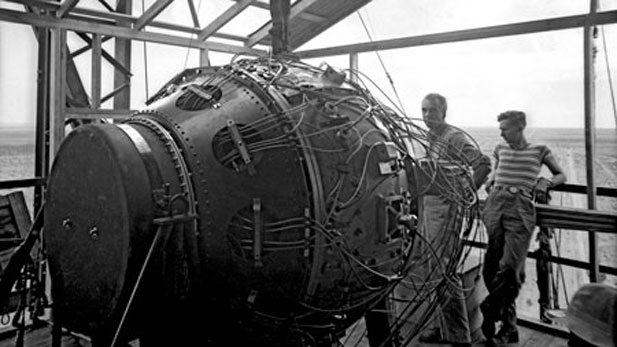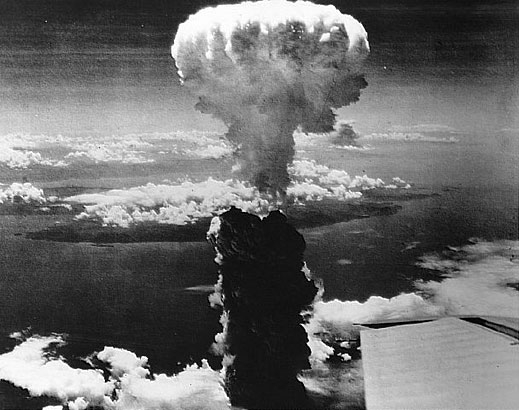Dakota Bush
History - Final Research Project
Nuclear Weapons: The Good, the Bad, and the Ugly
Beginning in August,
1942, with the Manhattan Project, the United States has been researching
nuclear power (partly) for the purpose of obtaining a nuclear arsenal. This
discovery- the atomic bomb- revealed to be a huge step in the field of science,
all the while bringing an entire amplitude of problems to face. On July 16,
1945, the United States conducts its first ever nuclear weapon, code-named
"Trinity," in New Mexico. This test marks the beginning of a rather
precarious age to come, of which the world is certainly not yet prepared to
meet. Following their first nuclear test and less than a month later, on August
6, the United States drops a uranium bomb named the "Little Boy" over
the Japanese city of Hiroshima, destroying 94% of the city and killing over
140,000 people in just a few months. Three days later, the United States drops
a plutonium bomb named the "Fat Man" over the city of Nagasaki,
destroying 44% of the city and killing an estimated 74,000 by the end of the
year. Six days later, Japan surrenders.
Clearly distressed
by the demonstration of sheer obliteration capable by nothing other than the
atomic bomb, the UN calls for the elimination of atomic weapons on January 24,
1946. At this assembly, the UN General Assembly requests the complete elimination
of nuclear weapons and any armaments capable of such "mass
destruction," as they set up a commission to deal with the problem of the
atomic discovery. Despite the assembly announcing the problems uprooted by the
discovery of atomic energy, it did not slow down nuclear expansion at the
slightest. Three years later, on August 29, the Soviet Union tests its first
nuclear weapon, code-named "First Lightning." The Soviet Union now
becomes the second nation to successfully develop and test a nuclear device.
Another three years later, the UK conducts its first nuclear test off the coast
of Australia. Less than a month afterwards, the United States tests the first
hydrogen bomb, named Ivy Mike, which is supposedly 500 times more powerful than
the Fat Man dropped on Nagasaki. The following year, the Soviet Union tests a
thermonuclear (hydrogen) device, and less than twenty years later, seven
nations have constructed thermonuclear bombs. Although the discovery of the
hydrogen bomb is a leap forward in studying the next stage of atomic weaponry,
it only accomplishes in speeding up the arms race.
Six years after the
first successful test of the thermonuclear bomb, the Campaign for Nuclear
Disarmament (CND) is formed. This organization retains a strong pacifistic
perspective, as it entirely opposes war and nuclear power, while the campaign
later sparks the flame for many marches and protests against the use of nuclear
weapons. The next year, the Antarctic Treaty is established, prohibiting any
nuclear tests in Antarctica. This treaty is not fully enforced until 1961, a
year after France tests their first nuclear weapon and the same year that the
Soviet Union detonates the most powerful bomb ever created (on October 30),
called the "Tsar Bomba." Almost a year later, the Cuban Missile
Crisis occurs, when the US discovers Soviet missiles in Cuba, resulting in the
US blockading Cuba for nearly two weeks, as the US and the Soviet Union are
brought to the brink of nuclear war. This caused a much greater recognition
towards the power and tension brought by nuclear weapons, with more arguments
forming that surround the "uselessness" of nuclear forces:
"'Nuclear weapons,' McNamara recently argued, 'serve no military purpose
whatsoever. They are totally useless---except only to deter one's opponent from
using them.'"[7] Less than a year later, following several
large protests against nuclear testing, and with the Cuban Missile Crisis
setting forth a clear demonstration of the ability for military and political
power to be influenced by nuclear weapons, the Partial Test Ban Treaty is
sanctioned (August 5, 1963), banning nuclear testing in the atmosphere,
underwater, and outer space. This advances the campaign of disarmament against
countries who hold nuclear weapons. Although, only three countries sign this
treaty: the Soviet Union, United Kingdom, and the United States.
A year after the
Partial Test Ban Treaty is enacted, China tests its first nuclear weapon,
having not signed the treaty. Three years later, on February 14, 1967, the
Treaty of Tlatelolco is signed at Mexico City, with the countries of Latin
America agreeing to not manufacture, test, or acquire nuclear weapons,
resulting in Latin America becoming nuclear-free. The next year, on July 1, the
Non-Proliferation Treaty is enacted, where non-nuclear-weapon states agree to
never acquire nuclear weapons, and the nuclear-weapon states make an effort
towards nuclear disarmament. This treaty accelerates the movement to attempt
nuclear disarmament as, just a little more than a decade later on June 12,
1982, a million people rally in New York City's Central Park in support of
disarmament, claiming this protest to be the largest anti-war demonstration in
history. Three years after the demonstration, the South Pacific becomes
nuclear-free under the South Pacific Nuclear Free Zone Treaty, which prohibits
the manufacturing, testing, or stationing of nuclear weapons within the region.
The next year on October 11-12, US President Ronald Reagan and Soviet President
Mikhail Gorbachev discuss the reality of possibly achieving nuclear abolition.
Over the next decade several efforts are made in the attempt to stop the
expansion of nuclear weapons, with South Africa joining the Non-Proliferation
Treaty and Southeast Asia, Ukraine, and Africa becoming nuclear-free. On July
8, 1996, the International Court of Justice states that the threat or use of
nuclear weapons is contrary to international law, as later that year on
September 24, the Comprehensive Nuclear Test Ban Treaty is enacted, stating
that all countries signed onto the treaty agree to ban all nuclear explosions
in all environments, for civilian or military purposes. This final treaty
closes the manufacturing and use of nuclear weapons for many countries, with
only four of the nine countries containing nuclear weapons not being legally
recognized nuclear weapon states (North Korea, Israel, Pakistan, India).
Through this
project, I have learned a great amount of history of which I did not know
before writing this, specifically relating to my study of Hiroshima and
Nagasaki following the bombing. I had no true perception of the ethics
surrounding the use of the atomic bomb in Japan from the point of view of
someone living in Japan. During my research, I found several accounts of the
incident that were recorded by the survivors, which gave me an insight into
their experiences during the frightening circumstances that they were put
through. Also, there were records of what was said inside of the plane before
dropping the bomb on Hiroshima, and even a record of the diary of Robert Lewis.
At the end of this project, I can say that my perspective on the usage of
nuclear weapons has changed from what it was prior to the project, as before,
my stance stood directly with the pursuit of science and advancing that through
researching nuclear power, but now my opinion has shifted to be more centered
as I would rather not pick a "yes" or "no" side in the
matter, as it may sway towards one side or the other depending on the
circumstances given.
CITED INFORMATION:
[1]: Kurzman, Dan. Day of the Bomb. New York: McGraw-Hill Book Company, 1986. 412
[3]: Lifton, Robert Jay, Greg Mitchell. Hiroshima in America: Fifty Years of Denial. New York: G.P. Putnam's Sons, 1995. 233.
[4]: Publishing Committee for 'Children of Hiroshima.' Children of Hiroshima. 1980. London: Taylor & Francis
[5]:Kurzman, Dan. Day of the Bomb. New York: McGraw-Hill Book Company, 1986. 412
[6]:Wyden, Peter. Day One. New York: Simon & Schuster, 1984. 293-294
[7]: Trachtenberg, Marc. The Influence of Nuclear Weapons in the Cuban Missile Crisis. 1985. 139
PICTURES:
| The Little Boy, used on Hiroshima (left) and the Fat Man, used on Nagasaki (right). |
 |
| "Trinity," the first nuclear bomb ever created. |
| "First Lightning," the first Soviet nuclear bomb. |
| The "Tsar Bomba," the most powerful nuclear bomb ever created. |
 |
| The mushroom cloud created by the bomb dropped on Nagasaki. |
SOURCES:
This site gave me useful information regarding the Manhattan Project as well as information surrounding the bombings of Hiroshima and Nagasaki, such as the numbers for the death toll and the severity of health issues brought upon survivors by the nuclear weapons.
This site (/book) explained (in detail) the steps taken during the campaign to abolish nuclear weapons.
This site told me what countries are labeled as “nuclear weapon states,” and which ones legally possess nuclear weapons.
This site contained a great timeline stating the important events during the Atomic Age, as it was a perfect reference source for knowing the important events from the site while using other sites to explain those events in detail.
This site explained the use and creation of the first thermonuclear bomb, as it gave me information regarding the intensity of the bomb and how the following year, the Soviets replicated the process and had created a thermonuclear bomb of their own.
This site, the Campaign for Nuclear Disarmament (of the UK), allowed me to see more in-depth towards the abolitionists viewpoints, also explaining why it is that they feel that way towards nuclear power/weapons.
This site (/book) explained the fears of nuclear war and the Cuban Missile Crisis, while also allowing me to cite McNamara’s words that were attacking the usage of nuclear weapons.

